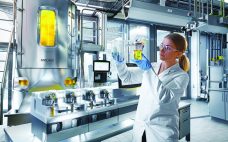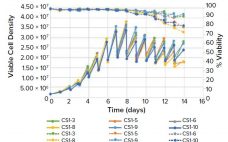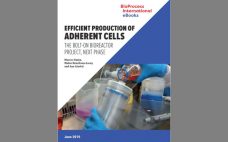Successful scale-up of cell culture for manufacturing of biopharmaceuticals gives companies time to accelerate clinical development, product commercialization, and market access (1). Scaling a cell culture process in stirred-tank bioreactors ideally includes optimizing that process at laboratory scale and then transferring it through larger pilot-scale and finally to manufacturing-scale bioreactors (2). This is a complex, time-consuming business that can involve process transfer — sometimes to different geographical locations and through many sizes of bioreactors, each of which can operate according…
Bioreactors
Navigating Technology Transfer
Technology transfer is a key milestone in the journey from discovery to full-scale good manufacturing practice (GMP)-compliant manufacturing. Navigating this step while preventing unforeseen issues that can create costly delays is supported best by combining knowledge of a given process with understanding of the technological capabilities. Different applications have different needs. Some challenges and goals are common to bioreactor processes for suspension and adherent cell culture for production of viral vectors, monoclonal antibodies (MAbs), other recombinant proteins, and vaccines. All…
Industrialize Your Viral Vector Production in Adherent and Suspension Cell Cultures: Know the Pros and Cons
This educational podcast, “The Evolution of Culture Systems for Viral Vector Production: Advantages, Challenges and Cost Considerations,” recently published by Cell and Gene Therapy Insights, discusses in detail the pros and cons of viral vector production in adherent and suspension cell culture. This special report illustrates how Pall Biotech’s iCELLis 500+ bioreactors and Allegro STR bioreactors can bolster adherent and suspension culture, respectively, for viral vector production. Fill out the form below to read the complete report and learn more now.…
Implementation of Single-Use Miniature Bioreactors to Support Intensified Cell Culture: Using Functional Performance Indicators to Assess a Small‑Scale Model
Changes to bioprocessing in the biopharmaceutical industry are driven by the need for increased speed, lower cost of goods (CoG), and greater flexibility (1). To meet these challenges, the industry is adopting strategies that include intensified processing. During the initial stages of intensified processing, it is essential to identify the most productive and/or stable clones for use before starting pilot-scale studies. That requires screening large numbers of clones and then further testing the most promising ones in benchtop bioreactors. The…
Matrix: The Highly Automated Multibioreactor Solution That Fits to Your Bench Space, Bioprocessing Needs, and Budget
To improve their bioprocess performance, life-science specialists need flexibility in their R&D laboratories because of constantly changing bioprocessing demands. In addition, more experiments need to be performed with more accuracy and reproducibility on less bench space than ever before — and with limited budgets. Therefore, having flexibility in the number of bioreactors that fit available bench space and budget is crucial — along with the flexibility to connect and integrate the right software, sampling tools, and analytical devices. Running multiple…
From Supplying Components to Providing Total Solutions: Overviewing Supplier Side Capabilities
Only a thin line now separates biopharmaceutical manufacturers and suppliers because the latter are increasingly becoming the process knowledge owners in the biopharmaceutical industry. As a result, suppliers are racing to become the most efficient “total solutions” provider. In the 1990s, leading players in the industry such as Pall, Millipore, and Sartorius all supplied membrane filters for upstream and, to some extent, downstream processes with their crossflow and final filtration offerings. Pharmacia (which became GE Healthcare) was the major force…
Production of Transient Lentiviral Vectors in HEK 293T Cells: Cultivation on Fibra-Cel Disks in a Single-Use, Packed-Bed, Stirred-Tank Bioreactor
Although demand for lentiviral vectors (LVs) for cell and gene therapy is increasing, the standard two-dimensional culture systems used to produce LVs present significant disadvantages. Current bottlenecks in LV production are caused mainly by such disadvantages. Switching to use of bioreactors can eliminate those problems because bioreactors offer the benefits of process automation, tight regulation of production conditions, and reduced labor input. The study reported herein was carried out by the group of David Parsons at the University of Adelaide.…
eBook: Bioreactor Scale-Up: From Pilot to Commercial Scale in the Modern Era
Upstream bioproduction always has begun with laboratory systems producing limited amounts of product for test purposes, then those bioprocesses are scaled up to make more product more efficiently for larger clinical trials — and ultimately commercial distribution. With the advent of single-use technology and continuous processing, how have scale-up approaches changed in recent years, specifically at the pilot-to-production level? In this online exclusive, BPI editors review the science and technology affecting decisions made at this stage of process development, with…
eBook: Efficient Production of Adherent Cells – The Bolt-On Bioreactor Project, Next Phase
Some years ago, The Bolt-on Bioreactor (BoB) project was launched with an objective of bringing to the market an efficient bioreactor for culturing adherent cells. The BoB team identified four challenges that needed be addressed to succeed: volumetric productivity, process automation, containment and sterility, and process economics. BPI published findings related to those challenges and proposals of the BoB team to solve them in a four-article series in 2015. Here, the author offers an update on developments in The Bolt-on…
A Brief History of Adherent Cell Culture: Where We Come From and Where We Should Go
In the past 20 years, novel therapeutics have become a major segment of biopharmaceutical research and development, particularly for immune disorders and cancer. Progress in gene therapies could bring cures for once deadly and debilitating genetic disorders such as hemophilia or muscular dystrophy. Biologic drug products offer potential treatments that have not been possible with traditional (chemistry-based) approaches. But such products also are more difficult to produce cost effectively at an industrial scale because of the intricacies associated with biological…










